Sediment Transport near Ship Shoal for Coastal Restoration in the Louisiana Shelf: A Model Estimate of the Year 2017–2018
Abstract
1. Introduction
2. Model Setup
3. Model Validation
3.1. Hydrodynamics Model Validation
3.2. Sediment Model Validation
4. Results
4.1. Averages for the Year 2017 to 2018
4.2. Sediment Dispersal
5. Discussion
5.1. Sediment Transport Flux near Ship Shoal
5.2. Application to Dredging Studies for Coastal Restoration
5.3. Comparison with Other Worldwide Major Rivers
5.4. Limitations and Future Work
6. Conclusions
- (1)
- Suspended fluvial sediment in the Atchafalaya River accumulated close to the river mouth and was confined to the continental shelf and bay mouth. Only a small portion of the sediments can transport to Ship Shoal within 15 m isobaths. The coastal current carried some Atchafalaya sediment westward.
- (2)
- Suspended mud from the Atchafalaya River can transport and pass above Ship Shoal. The sediment transport process between the bay and shelf exchange was dynamic in the ABSS. Suspended mud from the inner shelf could also be transported to even cross Ship Shoal and generate a thin mud layer, which was also considered as the primary sediment source infilling the Caminada dredge pit.
- (3)
- Since Ship Shoal was ~300 km east of the track line of Hurricane Harvey, its sediment transport was eastward. Ship Shoal was ~200 km west of the track line of Hurricane Nate, and its sediment transport was westward. Two hurricanes and one cold front changed the direction of the sediment flux near Ship Shoal, even though the distance between the hurricanes and Ship Shoal was more than 200 km. This indicated that hurricanes could bring a proportion of the sediment infilling pits in Ship Shoal. However, the hurricanes contributed less than 10% of the sediment infilling in both the Caminada and Raccoon Island dredge pits from July 2017 to October 2018 due to the great distances involved. This percentage can change dramatically for other hurricanes during other periods.
- (4)
- Our model also captured that the bottom sediment concentration in the Raccoon Island pit was relatively higher than the one in Caminada in the same period. The total sediment thickness in the Raccoon Island pit (~2.3 m) was greater than that in the Caminada pit (~0.25 m) in the ABSS model domain. Suspended mud sediment from the river, inner shelf, and bay can bypass or transport and deposit in the Caminada pit and Racoon Island pit, which showed that the Caminada and Raccoon Island pits would not be considered as renewable pits for future sand dredging activities for coastal restoration.
Author Contributions
Funding
Acknowledgments
Conflicts of Interest
References
- Chen, C.; Huang, H.; Beardsley, R.C.; Liu, H.; Xu, Q.; Cowles, G. A finite volume numerical approach for coastal ocean circulation studies: Comparisons with finite difference models. J. Geophys. Res. Ocean. 2007, 112–113. [Google Scholar] [CrossRef]
- Harris, C.K.; Sherwood, C.R.; Signell, R.P.; Bever, A.J.; Warner, J.C. Sediment dispersal in the northwestern Adriatic Sea. J. Geophys. Res. Ocean. 2008, 113–114. [Google Scholar] [CrossRef]
- Warner, J.C.; Armstrong, B.; He, R.; Zambon, J.B. Development of a coupled ocean–atmosphere–wave–sediment transport (COAWST) modeling system. Ocean. Model. 2010, 35, 230–244. [Google Scholar] [CrossRef]
- Amoudry, L. A Review on Coastal Sediment Transport Modelling; Proudman Oceanographic Laboratory: Liverpool, UK, 2008; pp. 1–44. [Google Scholar]
- Caldwell, R.L.; Edmonds, D.A. The effects of sediment properties on deltaic processes and morphologies: A numerical modeling study. J. Geophys. Res. Earth Surf. 2014, 119, 961–982. [Google Scholar] [CrossRef]
- Lesser, G.R.; Roelvink, J.V.; Van Kester, J.; Stelling, G. Development and validation of a three-dimensional morphological model. Coast. Eng. 2004, 51, 883–915. [Google Scholar] [CrossRef]
- Diesing, M.; Green, S.L.; Stephens, D.; Lark, R.M.; Stewart, H.A.; Dove, D. Mapping seabed sediments: Comparison of manual, geostatistical, object-based image analysis and machine learning approaches. Cont. Shelf Res. 2014, 84, 107–119. [Google Scholar] [CrossRef]
- Lacharité, M.; Brown, C.J.; Gazzola, V. Multisource multibeam backscatter data: Developing a strategy for the production of benthic habitat maps using semi-automated seafloor classification methods. Mar. Geophys. Res. 2018, 39, 307–322. [Google Scholar] [CrossRef]
- Liu, H.; Xu, K.; Li, B.; Han, Y.; Li, G. Sediment Identification Using Machine Learning Classifiers in a Mixed-Texture Dredge Pit of Louisiana Shelf for Coastal Restoration. Water 2019, 11, 1257. [Google Scholar] [CrossRef]
- Stephens, D.; Diesing, M. A comparison of supervised classification methods for the prediction of substrate type using multibeam acoustic and legacy grain-size data. PLoS ONE 2014, 9, e93950. [Google Scholar] [CrossRef]
- Haidvogel, D.B.; Arango, H.; Budgell, W.P.; Cornuelle, B.D.; Curchitser, E.; Di Lorenzo, E.; Fennel, K.; Geyer, W.R.; Hermann, A.J.; Lanerolle, L. Ocean forecasting in terrain-following coordinates: Formulation and skill assessment of the Regional Ocean Modeling System. J. Comput. Phys. 2008, 227, 3595–3624. [Google Scholar] [CrossRef]
- Shchepetkin, A.F.; McWilliams, J.C. The regional oceanic modeling system (ROMS): A split-explicit, free-surface, topography-following-coordinate oceanic model. Ocean. Model. 2005, 9, 347–404. [Google Scholar] [CrossRef]
- Warner, J.C.; Sherwood, C.R.; Signell, R.P.; Harris, C.K.; Arango, H.G. Development of a three-dimensional, regional, coupled wave, current, and sediment-transport model. Comput. Geosci. 2008, 34, 1284–1306. [Google Scholar] [CrossRef]
- Kumar, N.; Voulgaris, G.; Warner, J.C.; Olabarrieta, M. Implementation of the vortex force formalism in the coupled ocean-atmosphere-wave-sediment transport (COAWST) modeling system for inner shelf and surf zone applications. Ocean. Model. 2012, 47, 65–95. [Google Scholar] [CrossRef]
- Xu, K.; Mickey, R.C.; Chen, Q.; Harris, C.K.; Hetland, R.D.; Hu, K.; Wang, J. Shelf sediment transport during hurricanes Katrina and Rita. Comput. Geosci. 2016, 90, 24–39. [Google Scholar] [CrossRef]
- Moriarty, J.; Harris, C.K.; Friedrichs, M.A.; Fennel, K.; Xu, K. A Model Archive for a Coupled Hydrodynamic-Sediment Transport-Biogeochemistry Model for the Northern Gulf of Mexico, Mexico, USA; US Geological Survey: Reston, VA, USA, 2018.
- Zang, Z.; Xue, Z.G.; Xu, K.; Bentley, S.J.; Chen, Q.; D’Sa, E.J.; Ge, Q. A Two Decadal (1993–2012) Numerical Assessment of Sediment Dynamics in the Northern Gulf of Mexico. Water 2019, 11, 938. [Google Scholar] [CrossRef]
- Allison, M.A.; Ramirez, M.T.; Meselhe, E.A. Diversion of Mississippi River water downstream of New Orleans, Louisiana, USA to maximize sediment capture and ameliorate coastal land loss. Water Resour. Manag. 2014, 28, 4113–4126. [Google Scholar] [CrossRef]
- Twilley, R.R.; Bentley, S.J.; Chen, Q.; Edmonds, D.A.; Hagen, S.C.; Lam, N.S.N.; Willson, C.S.; Xu, K.; Braud, D.; Peele, R.H. Co-evolution of wetland landscapes, flooding, and human settlement in the Mississippi River Delta Plain. Sustain. Sci. 2016, 11, 711–731. [Google Scholar] [CrossRef]
- Khalil, S.M.; Finkl, C.W.; Roberts, H.H.; Raynie, R.C. New Approaches to Sediment Management on the Inner Continental Shelf Offshore Coastal Louisiana. J. Coast. Res. 2010, 591–604. [Google Scholar] [CrossRef]
- Hanley, M.; Hoggart, S.; Simmonds, D.; Bichot, A.; Colangelo, M.; Bozzeda, F.; Heurtefeux, H.; Ondiviela, B.; Ostrowski, R.; Recio, M. Shifting sands? Coastal protection by sand banks, beaches and dunes. Coast. Eng. 2014, 87, 136–146. [Google Scholar] [CrossRef]
- Jonah, F.E.; Adjei-Boateng, D.; Agbo, N.W.; Mensah, E.A.; Edziyie, R.E. Assessment of sand and stone mining along the coastline of Cape Coast, Ghana. Ann. Gis. 2015, 21, 223–231. [Google Scholar] [CrossRef]
- Rangel-Buitrago, N.G.; Anfuso, G.; Williams, A.T. Coastal erosion along the Caribbean coast of Colombia: Magnitudes, causes and management. Ocean. Coast. Manag. 2015, 114, 129–144. [Google Scholar] [CrossRef]
- Brown, J.M.; Amoudry, L.O.; Souza, A.J.; Rees, J. Fate and pathways of dredged estuarine sediment spoil in response to variable sediment size and baroclinic coastal circulation. J. Environ. Manag. 2015, 149, 209–221. [Google Scholar] [CrossRef]
- Stone, G.W.; Pepper, D.A.; Xu, J.; Zhang, X. Ship Shoal as a Prospective Borrow Site for Barrier Island Restoration, Coastal South-Central Louisiana, USA: Numerical Wave Modeling and Field Measurements of Hydrodynamics and Sediment Transport. J. Coast. Res. 2004, 201, 70–88. [Google Scholar] [CrossRef]
- Kobashi, D.; Jose, F.; Stone, G.W. Impacts of Fluvial Fine Sediments and Winter Storms on a Transgressive Shoal, off South-Central Louisiana, U.S.A. J. Coast. Res. 2007, 36, 858–862. [Google Scholar]
- CEC; C.E.C.I. NRDA Caminada Headland Beach and Dune Restoration, Increment II (BA-143) Completion Report; Preparation Coastal Protection and Restororation Authority: Baton Rouge, LA, USA, 2017; p. 63.
- Dartez, J.S. The Biggest, The Baddest, and The Bestest–Coastal Restoration Cajun Style. In Proceedings of the Twenty. First World Dredg. Congr. Wodcon Xxi, Miami, FL, USA, 13–17 June 2016; pp. 1–55. [Google Scholar]
- Liu, H.; Xu, K.; Li, B.; Han, Y.; Li, G. Machine-learning classifiers applied to sediment identification for coastal restoration near Ship Shoal in Louisiana. In Proceedings of the CERF Biennial Conference, Mobile, AL, USA, 3–7 November 2019. [Google Scholar]
- Liu, H.; Xu, K.; Bentley, S.; Wilson, C.; Xue, Z.; Miner, M. Sediment Transport and Geomorphologic Response in Multiple Dredge Pits Near Ship Shoal of Coastal Louisiana. In Proceedings of the AGU Fall Meeting Abstracts, Walter E Washington Convention Center, Washington, DC, USA, 14 December 2018. [Google Scholar]
- Stone, G.; Condrey, R.; Fleeger, J.; Khalil, S.; Kobashi, D.; Jose, F.; Evers, E.; Dubois, S.; Liu, B.; Arndt, S. Environmental Investigation of Long-Term Use of Ship Shoal Sand Resources for Large Scale Beach and Coastal Restoration in Louisiana; U.S. Department of the Interior Minerals Management Service Gulf of Mexico OCS Regio: New Orleans, LA, USA, 2009; p. 278.
- Xu, K.; Bargu, S.; Bentley, S.J.; Duplantis, B.; Li, C.; Maiti, K.; Miner, M.D.; White, J.R.; Wilson, C.; Xue, Z.G. Sediment Transport and Water Quality of a Dredge Pit on Louisiana Shelf for Coastal Restoration. In Proceedings of the AGU Fall Meeting Abstracts, Washington, DC, USA, 14 December 2018. [Google Scholar]
- Liu, H.; Xu, K.; Bentley, S.; Li, C.; Miner, M.; Wilson, C.; Xue, Z. Sediment Transport and Slope Stability of Ship Shoal Borrow Areas for Coastal Restoration of Louisiana. In Proceedings of the AGU Fall Meeting Abstracts, New Orleans, LA, USA, 14 December 2017. [Google Scholar]
- O’Connor, M.C.; Bentley, S.; Xu, K.; Obelcz, J.; Li, C.; Miner, M. Sediment Infilling of Louisiana Continental-Shelf Dredge Pits: A Record of Sedimentary Processes in the Northern Gulf of Mexico. In Proceedings of the American Geophysical Union, Ocean Sciences Meeting, New Orleans, LA, USA, 21–26 February 2016. [Google Scholar]
- Xue, Z.; Wilson, C.; Bentley, S.J.; Xu, K.; Liu, H.; Li, C.; Miner, M.D. Quantifying Sediment Characteristics and Infilling Rate within a Ship Shoal Dredge Borrow Area, Offshore Louisiana. In Proceedings of the AGU Fall Meeting Abstracts, New Orleans, LA, USA, 14 December 2017. [Google Scholar]
- Styles, R.; Glenn, S.M. Modeling stratified wave and current bottom boundary layers on the continental shelf. J. Geophys. Res. Ocean. 2000, 105, 24119–24139. [Google Scholar] [CrossRef]
- Harris, C.K.; Wiberg, P.L. A two-dimensional, time-dependent model of suspended sediment transport and bed reworking for continental shelves. Comput. Geosci. 2001, 27, 675–690. [Google Scholar] [CrossRef]
- Survey, G.; Buczkowski, B.J. usSEABED: Gulf of Mexico and Caribbean (Puerto Rico and US Virgin Islands) Offshore Surficial-Sediment Data Release; US Department of the Interior, US Geological Survey: Reston, VA, USA, 2006.
- Xu, K.; Harris, C.K.; Hetland, R.D.; Kaihatu, J.M. Dispersal of Mississippi and Atchafalaya Sediment on the Texas–Louisiana shelf: Model Estimates For the Year 1993. Cont. Shelf Res. 2011, 31, 1558–1575. [Google Scholar] [CrossRef]
- Miller, R.L.; McKee, B.A. Using MODIS Terra 250 m imagery to map concentrations of total suspended matter in coastal waters. Remote Sens. Environ. 2004, 93, 259–266. [Google Scholar] [CrossRef]
- Sherwood, C.R.; Aretxabaleta, A.L.; Harris, C.K.; Rinehimer, J.P.; Verney, R.; Ferré, B. Cohesive and mixed sediment in the Regional Ocean Modeling System (ROMS v3. 6) implemented in the Coupled Ocean-Atmosphere-Wave-Sediment Transport Modeling System (COAWST r1234). Geosci. Model Dev. 2018, 11, 1849–1871. [Google Scholar] [CrossRef]
- Nairn, R.; Lu, Q.; Langendyk, S. A Study to Address the Issue of sSeafloor Stability and the Impact on Oil and Gas Infrastructure in the Gulf of Mexico; U.S. Department Of The Interior Minerals Management Service Gulf Mex. Ocs Reg: New Orleans, LA, USA, 2005; p. 179.
- Liu, H.; Xu, K.; Li, B. Sediment types identification and seafloor geomorphology classification through machine learning in Buzzards Bay, Massachusetts. In Proceedings of the Ocean Sciences Meeting, San Diego, CA, USA, 16–21 February 2020. [Google Scholar]
- Fletcher, C.H., III; Knebel, H.J.; Kraft, J.C. Holocene depocenter migration and sediment accumulation in Delaware Bay: A submerging marginal marine sedimentary basin. Mar. Geol. 1992, 103, 165–183. [Google Scholar] [CrossRef]
- Walsh, J.; Nittrouer, C. Understanding fine-grained river-sediment dispersal on continental margins. Mar. Geol. 2009, 263, 34–45. [Google Scholar] [CrossRef]
- Baker, E.T.; Hickey, B.M. Contemporary sedimentation processes in and around an active west coast submarine canyon. Mar. Geol. 1986, 71, 15–34. [Google Scholar] [CrossRef]
- Kuehl, S.A.; Hariu, T.M.; Moore, W.S. Shelf sedimentation off the Ganges-Brahmaputra river system: Evidence for sediment bypassing to the Bengal fan. Geology 1989, 17, 1132–1135. [Google Scholar] [CrossRef]
- Nittrouer, C.; DeMaster, D.; McKee, B. Fine-scale stratigraphy in proximal and distal deposits of sediment dispersal systems in the East China Sea. Mar. Geol. 1984, 61, 13–24. [Google Scholar] [CrossRef]
- Nittrouer, C.; Kuehl, S.; DeMaster, D.; Kowsmann, R. The deltaic nature of Amazon shelf sedimentation. Geol. Soc. Am. Bull. 1986, 97, 444–458. [Google Scholar] [CrossRef]
- Hupp, C.R.; Demas, C.R.; Kroes, D.E.; Day, R.H.; Doyle, T.W. Recent sedimentation patterns within the central Atchafalaya Basin, Louisiana. Wetlands 2008, 28, 125–140. [Google Scholar] [CrossRef]
- Roberts, H.H. Dynamic changes of the Holocene Mississippi River delta plain: The delta cycle. J. Coast. Res. 1997, 13, 605–627. [Google Scholar]
- Wang, J.; Xu, K.; Bentley, S.J.; White, C.; Zhang, X.; Liu, H. Degradation of the plaquemines sub-delta and relative sea-level in eastern Mississippi deltaic coast during late holocene. Estuar. Coast. Shelf Sci. 2019, 227, 106344. [Google Scholar] [CrossRef]
- Sheremet, A.; Jaramillo, S.; Su, S.F.; Allison, M.; Holland, K. Wave-mud interaction over the muddy Atchafalaya subaqueous clinoform, Louisiana, United States: Wave processes. J. Geophys. Res. Ocean. 2011, 116. [Google Scholar] [CrossRef]
- Traykovski, P.; Trowbridge, J.; Kineke, G. Mechanisms of surface wave energy dissipation over a high-concentration sediment suspension. J. Geophys. Res. Ocean. 2015, 120, 1638–1681. [Google Scholar] [CrossRef]
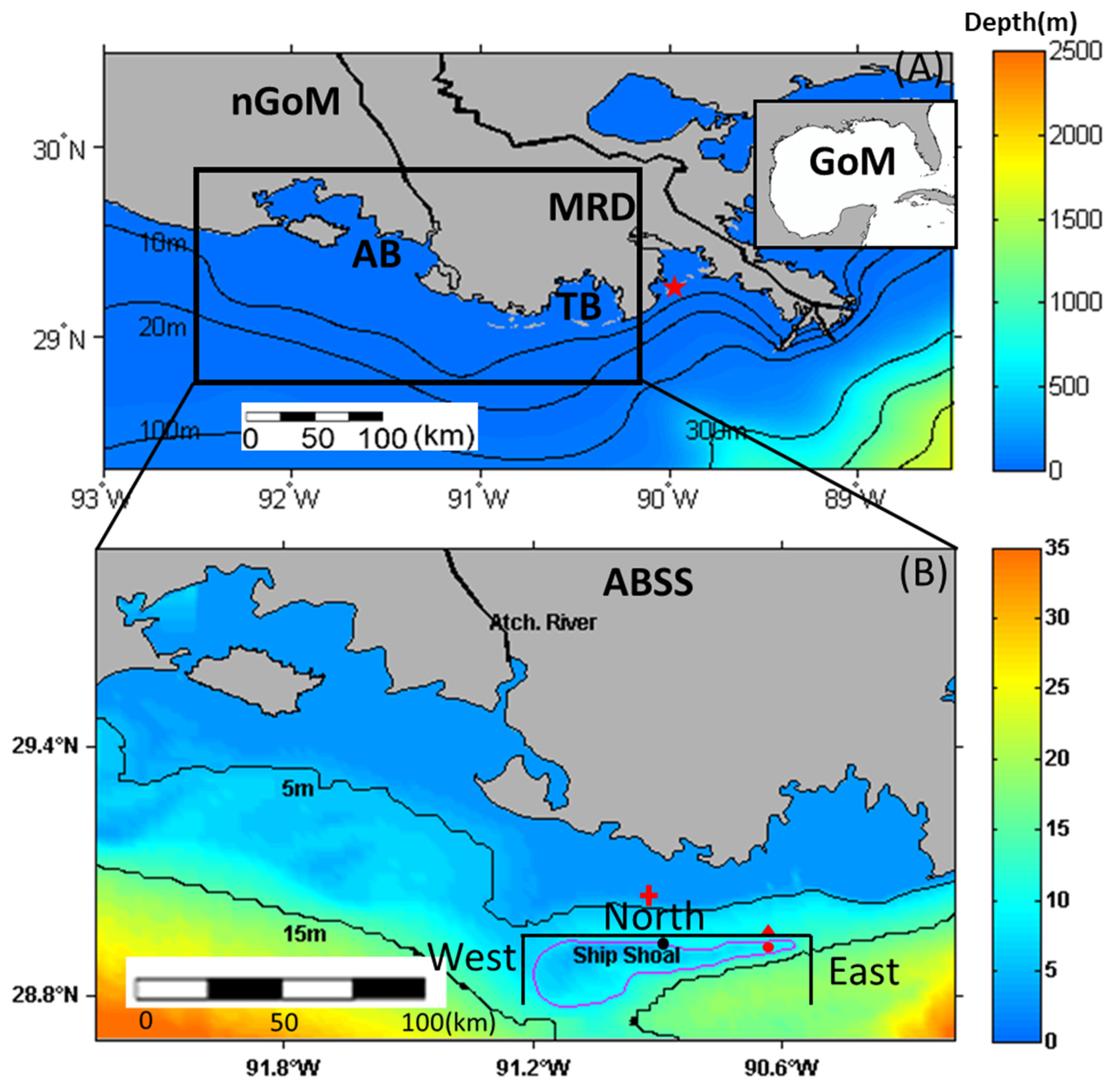
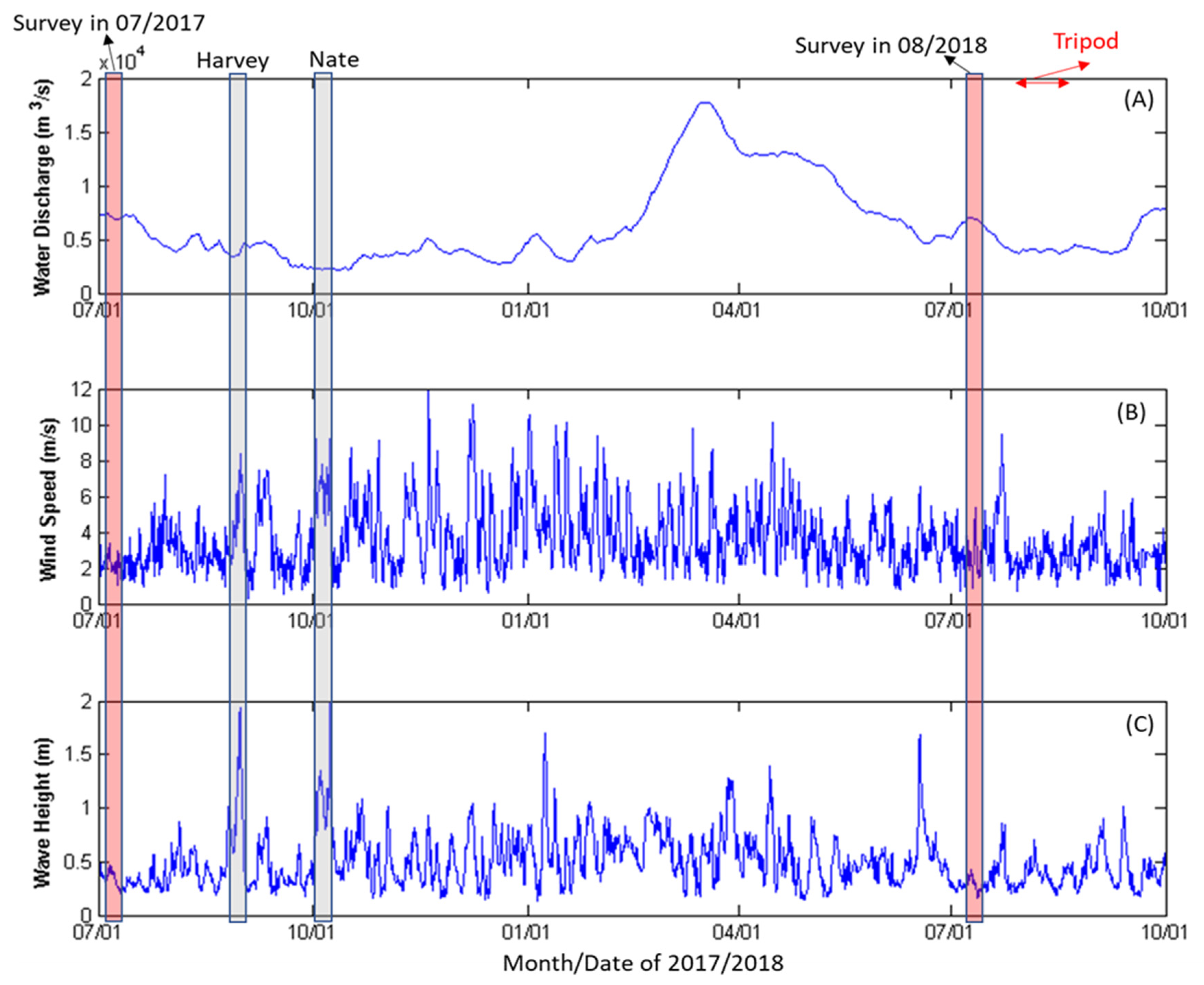
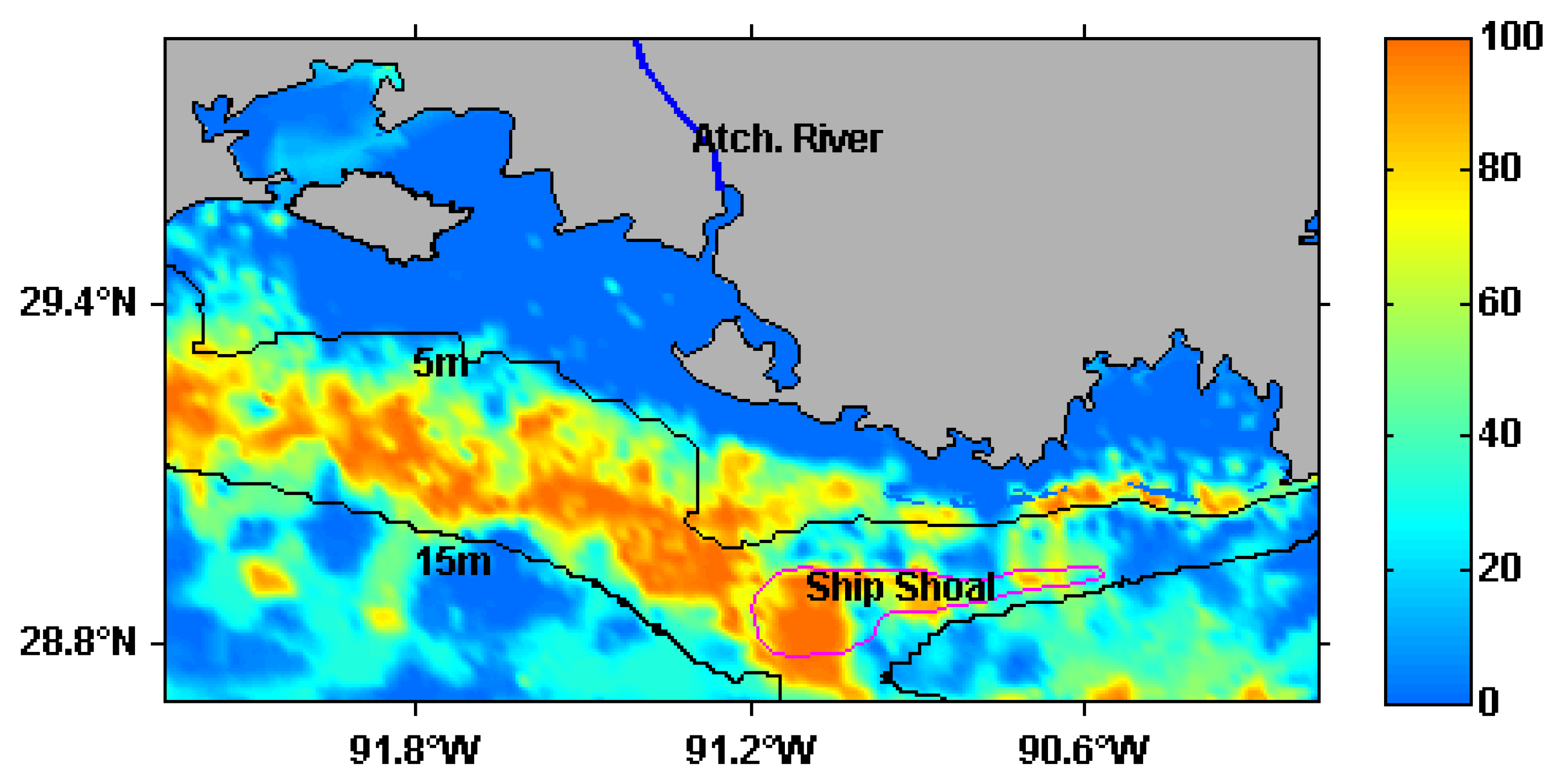
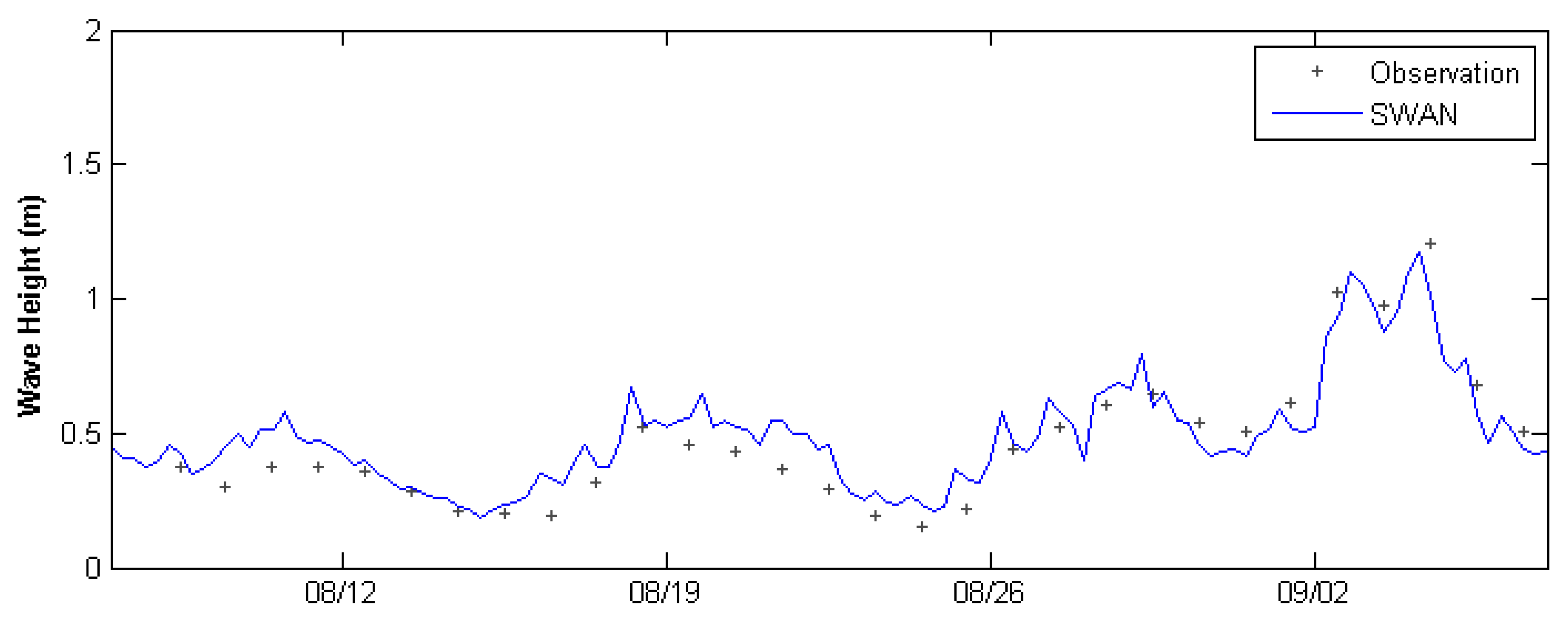
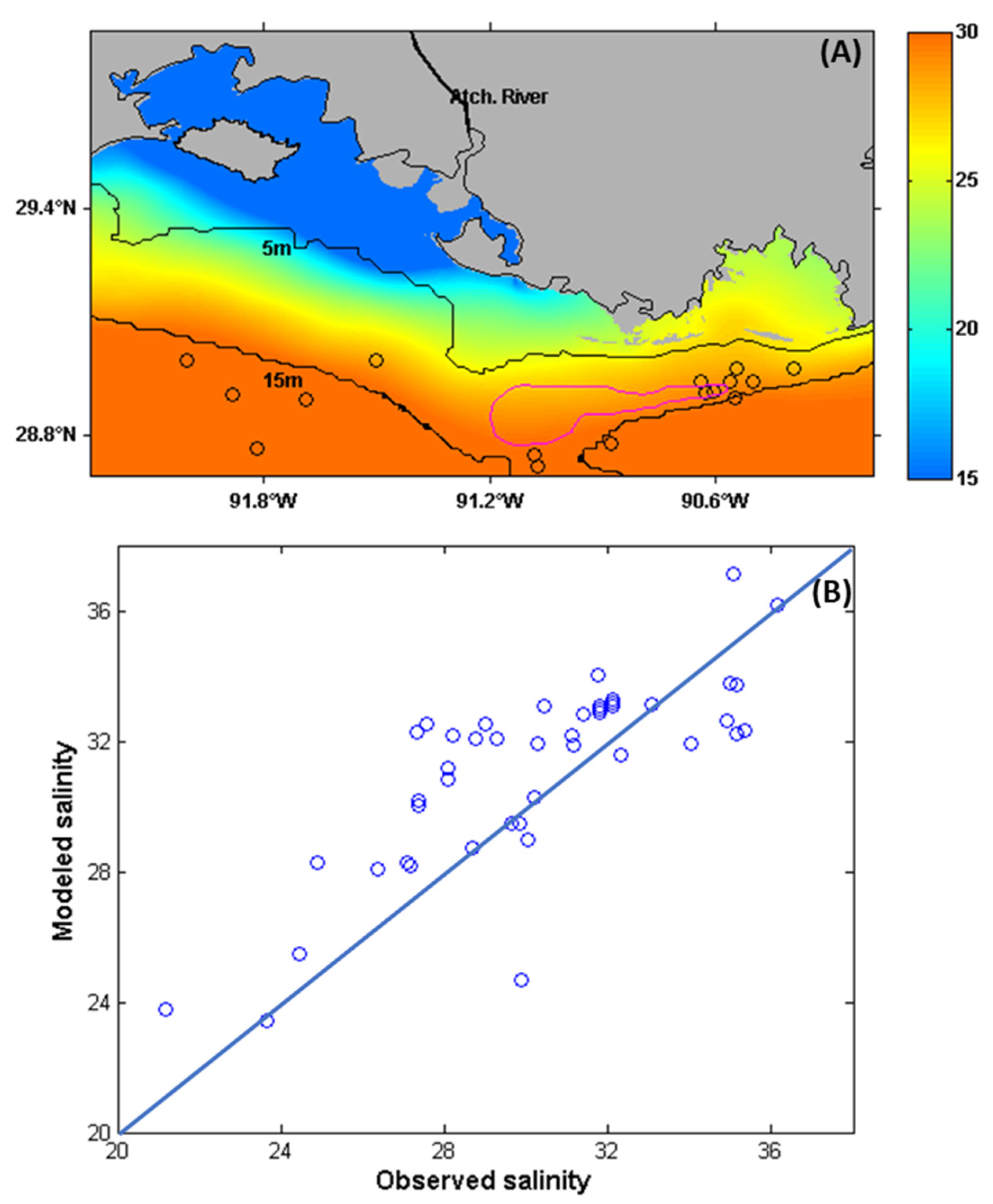
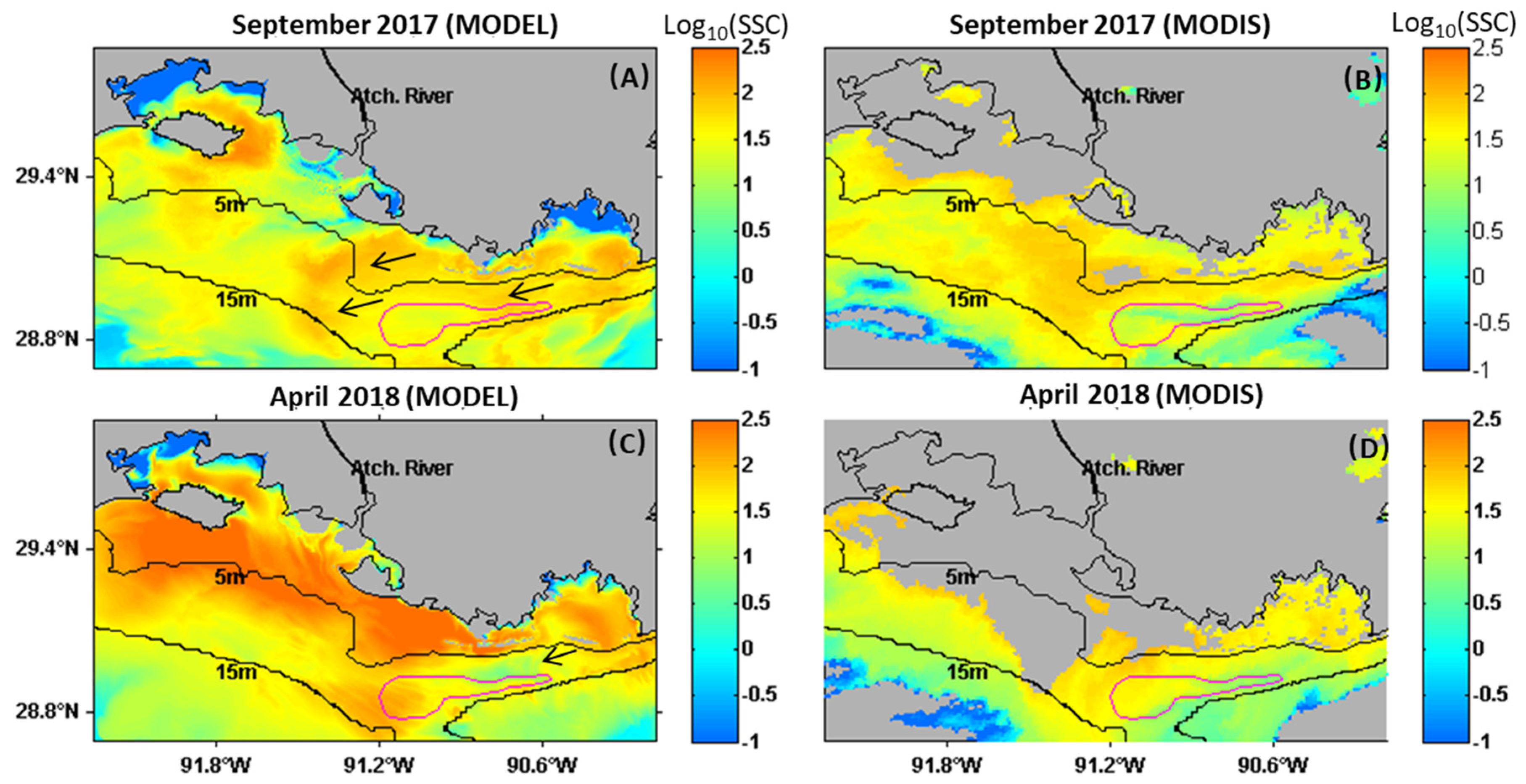
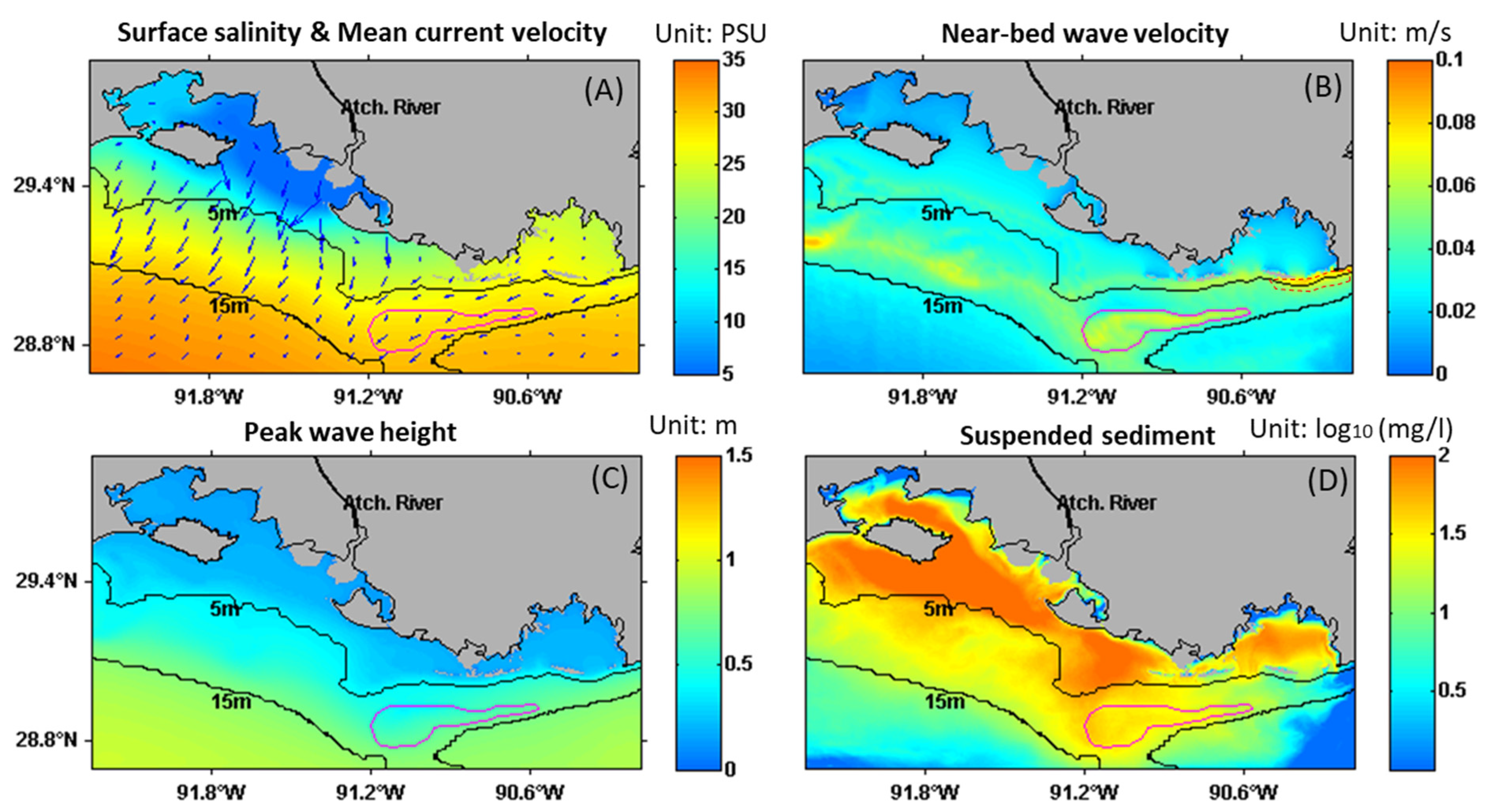
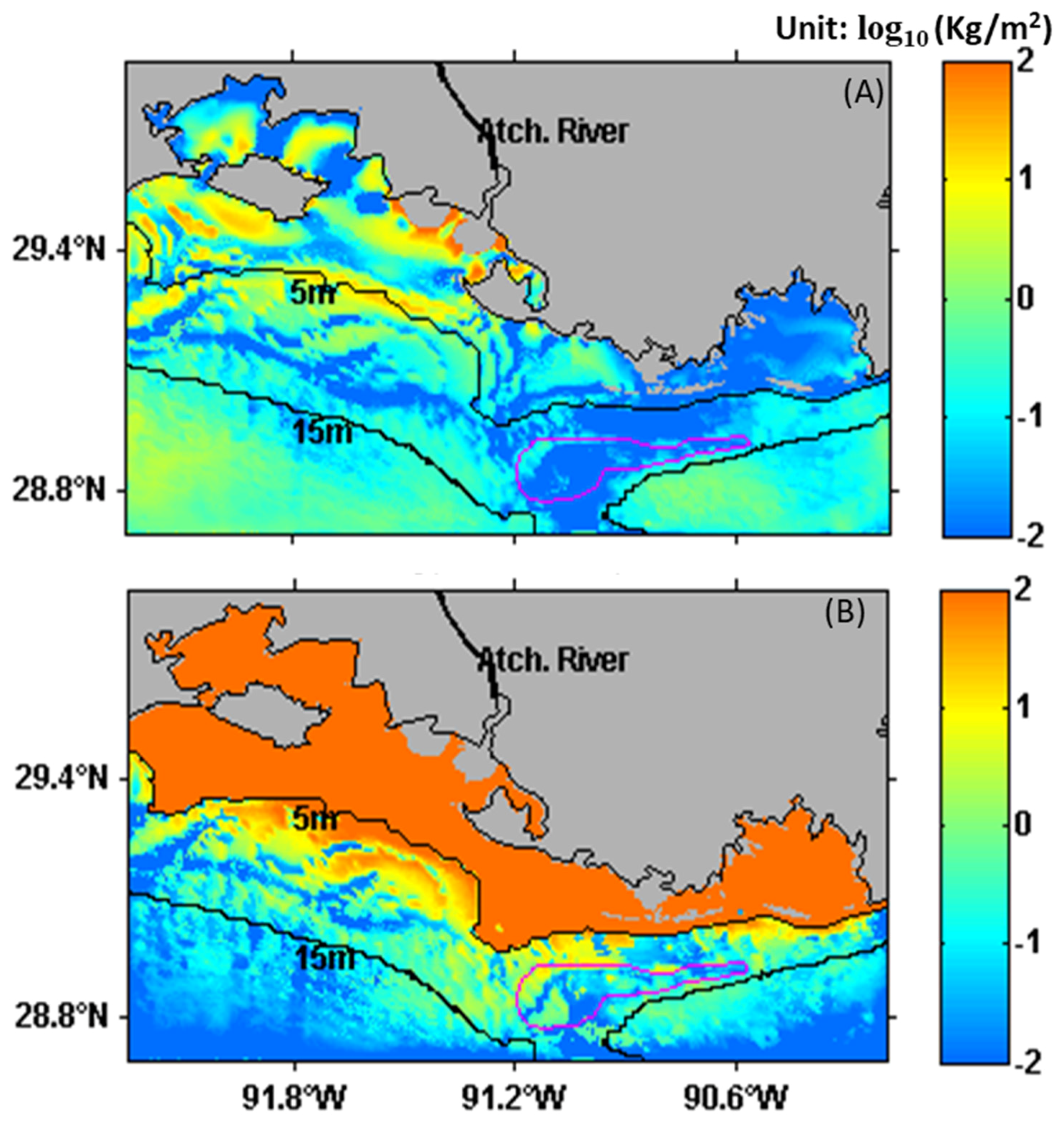
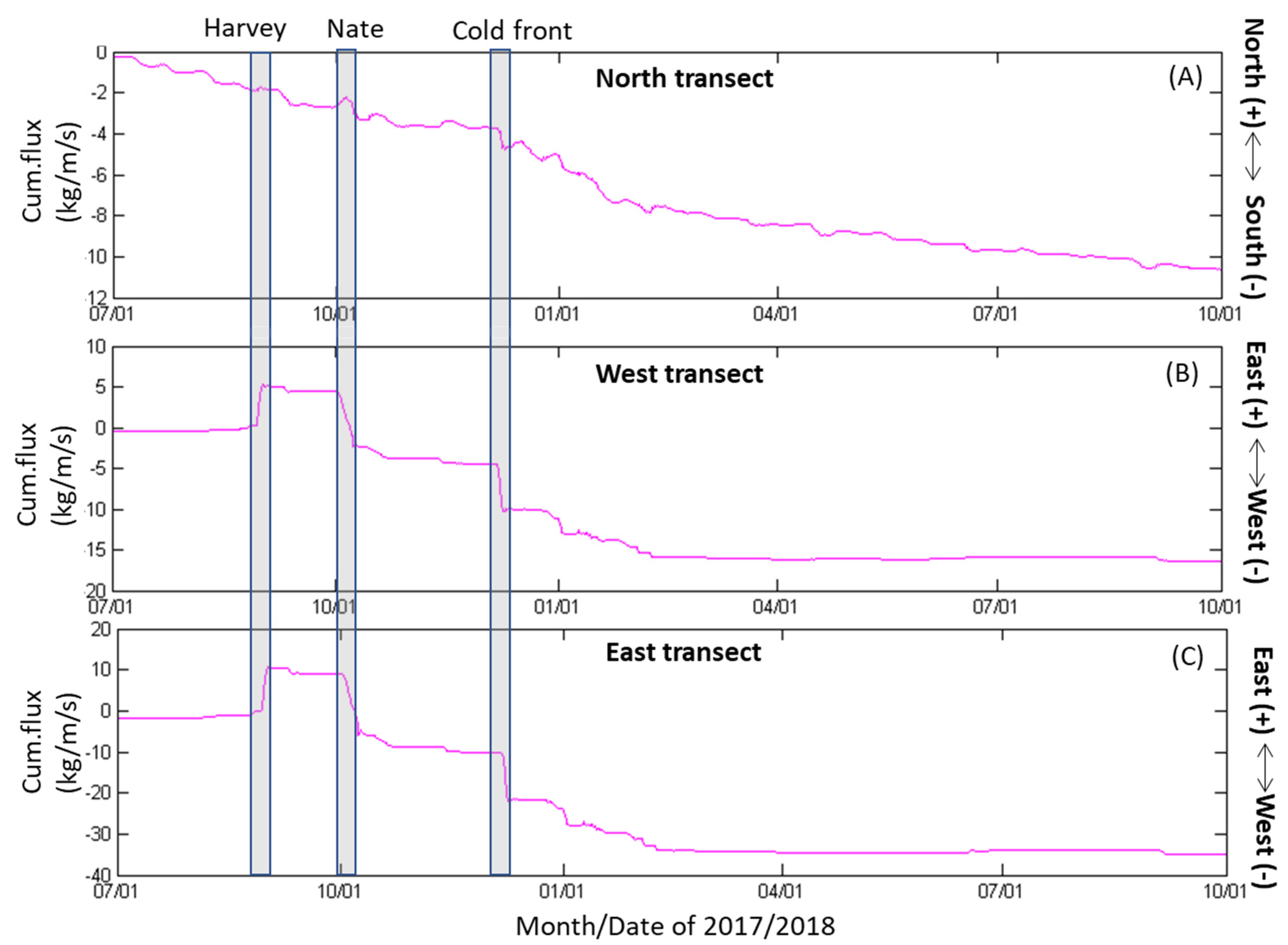
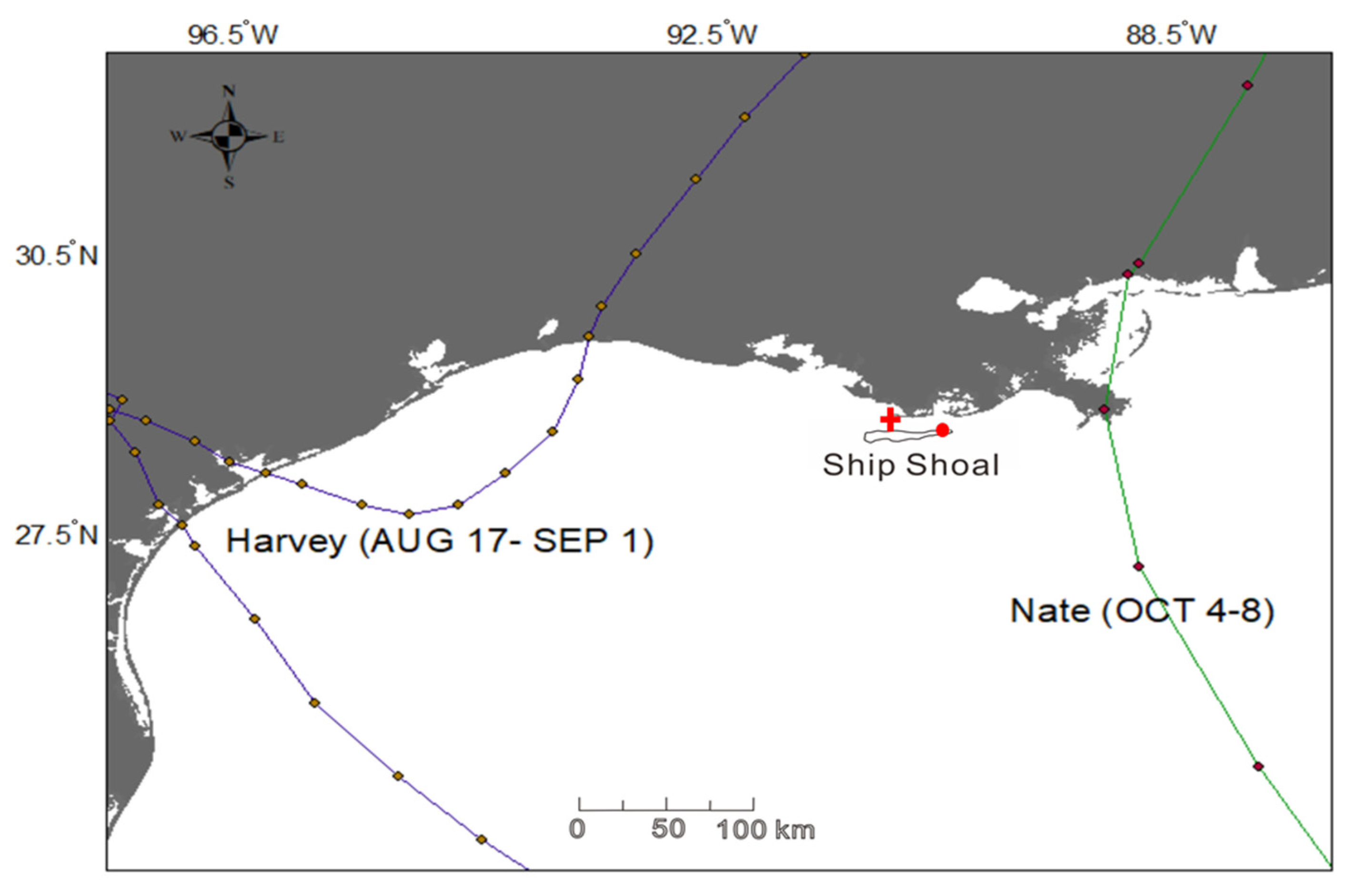
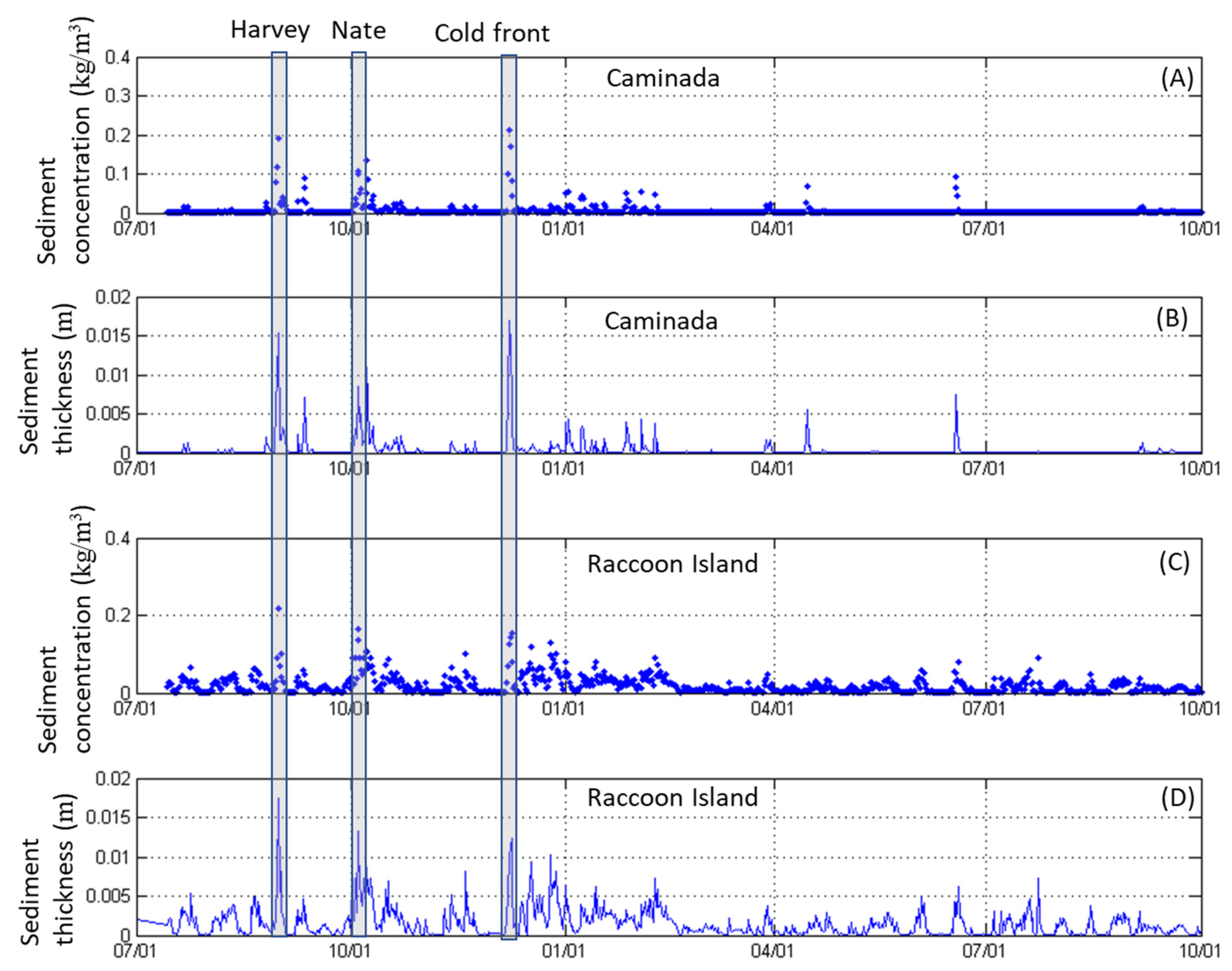
| Sediment Type | Grain Diameter (mm) | Settling Velocity (mm/s) | Critical Shear Stress (Pa) | Erosional Rate (10−4 kg/m2/s) |
|---|---|---|---|---|
| Mud_01(Mississippi River) | 0.004 | 0.1 | 0.1 | 5 |
| Mud_02(Mississippi River) | 0.03 | 0.1 | 0.16 | 5 |
| Mud_03(Atchafalaya River) | 0.004 | 0.1 | 0.1 | 5 |
| Mud_04(Atchafalaya River) | 0.03 | 0.1 | 0.16 | 5 |
| Mud_05(Shallow mud) | 0.004 | 0.1 | 0.1 | 5 |
| Mud_06(Deep mud) | 0.004 | 0.1 | 0.1 | 5 |
| Sand_01(Mississippi River) | 0.0625 | 1 | 0.2 | 5 |
| Sand_02(Atchafalaya River) | 0.0625 | 1 | 0.2 | 5 |
| Sand_03(Shallow sand) | 0.0625 | 1 | 0.2 | 5 |
| Sand_04(Deep sand) | 0.0625 | 1 | 0.2 | 5 |
| River | Drainage Basin Area (km2 × 106) | Water Discharge (km3/year) | Sediment Load (Mt/year) | Wave Height/Tide Range (m) | Shelf Width (km) | Sediment Dispersal Stage | References |
|---|---|---|---|---|---|---|---|
| Delaware | 0.03 | 11.7 | 1 | 1.2/1.7 | 133 | EAD | [44] |
| Columbia | 0.67 | 251 | 15 | 2.9/2.5 | 49 | MDD | [46] |
| Ganges | 1.08 | 378 | 1060 | 0.9/3.6 | 321 | SDC | [47] |
| Amazon | 6.15 | 6300 | 1200 | 1.1/4.8 | 330 | SDC | [48] |
| Yangtze | 1.94 | 900 | 480 | 1.1/3.4 | 557 | SDC | [49] |
| Mississippi | 327 | 580 | 400 | 0.9/0.3 | 15 | PAD | [18] |
| Atchafalaya | 0.006 | 315 | 0.54 | 0.5/0.2 | 140 | PAD + MDD | [39,45] |
© 2020 by the authors. Licensee MDPI, Basel, Switzerland. This article is an open access article distributed under the terms and conditions of the Creative Commons Attribution (CC BY) license (http://creativecommons.org/licenses/by/4.0/).
Share and Cite
Liu, H.; Xu, K.; Ou, Y.; Bales, R.; Zang, Z.; Xue, Z.G. Sediment Transport near Ship Shoal for Coastal Restoration in the Louisiana Shelf: A Model Estimate of the Year 2017–2018. Water 2020, 12, 2212. https://doi.org/10.3390/w12082212
Liu H, Xu K, Ou Y, Bales R, Zang Z, Xue ZG. Sediment Transport near Ship Shoal for Coastal Restoration in the Louisiana Shelf: A Model Estimate of the Year 2017–2018. Water. 2020; 12(8):2212. https://doi.org/10.3390/w12082212
Chicago/Turabian StyleLiu, Haoran, Kehui Xu, Yanda Ou, Robert Bales, Zhengchen Zang, and Z. George Xue. 2020. "Sediment Transport near Ship Shoal for Coastal Restoration in the Louisiana Shelf: A Model Estimate of the Year 2017–2018" Water 12, no. 8: 2212. https://doi.org/10.3390/w12082212
APA StyleLiu, H., Xu, K., Ou, Y., Bales, R., Zang, Z., & Xue, Z. G. (2020). Sediment Transport near Ship Shoal for Coastal Restoration in the Louisiana Shelf: A Model Estimate of the Year 2017–2018. Water, 12(8), 2212. https://doi.org/10.3390/w12082212






